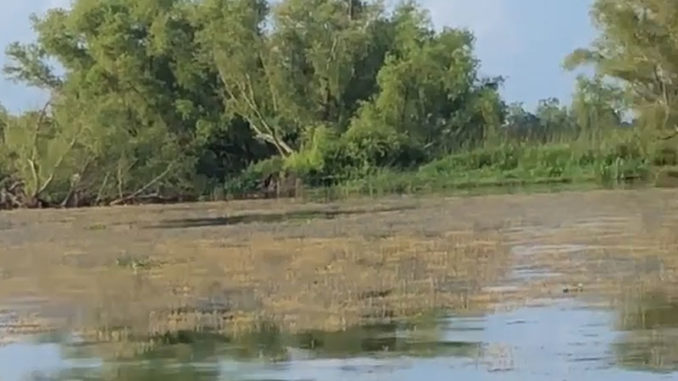
Anglers have reported seeing brown and dying aquatic grass at Lake Cataouatche, which is a cause for concern given the lake’s history.
According to reports, the afflicted grass is concentrated along the canal from Pier 90 to the main lake and in the tank pond, where a proliferation of gas bubbles was seen erupting on the surface.
However, a study conducted last week by biologists with the Louisiana Department of Wildlife and Fisheries into the health of submerged aquatic vegetation (SAVs) showed continued improvement, suggesting that the reported die-off is isolated. Recent LDWF efforts to clear the boat launch at Pier 90 and the canal of water hyacinth, as well as natural, cyclical processes appear to be the causes of the brown vegetation and gas bubbles reported in the tank pond.
A history of highs and lows
Lake Cataouatche, in Jefferson and St. Charles parishes, has seen its fair share of highs and lows in the past 30 years. In the 1990s, talk about the lake centered on a bygone era of abundance and the saltwater intrusion that ruined it all. But the early 2000s saw a change in Cataouatche’s fortunes, beginning with the completion of Davis Pond, a U.S. Army Corps of Engineers project to bring fresh water from the Mississippi River into the lake.
The change was immediate. By 2007, the fabled grass that old-timers saw back in the 1950s had returned. The lake saw an explosion of aquatic vegetation with some reports suggesting more than 90% coverage.
Lake Cataouatche’s turn-around culminated in 2011, when bass pro Kevin VanDam won his fourth Bassmaster Classic on the lake, but by then, the epic grass beds had probably already peaked and begun to decline.
Shortly before VanDam’s win, the USACE completed alterations to the diversion system that increased the amount of water moving through it, allowing muddy water to pass into the lake without going through the sedimentation pond, eventually killing off the hydrilla and other aquatic vegetation by denying it adequate sunlight.
Although the reasons given for the die-off of the hydrilla are pure speculation, the die-off did occur, and those world-class grass beds became the stuff of legend once again, which brings us to the present.
Things are looking up
Gary Vitrano, a biologist with LDWF, shared an overview of the situation at Lake Cataouatche.
“We did a survey last week for the SAVs, and it looked pretty good,” Vitrano said, “especially compared to the last survey (2017).
“You’ve got some pretty good coverage in the Netherlands and in the tank pond,” he said, “and then there is a fringe of submerged aquatic vegetation along the edge of the lake in certain areas; coverage is up since our last survey.”
Overall, he said things are looking better at Lake Cataouatche.
“Let me put it this way,” Vitrano said, “it’s not where it was back in 2007, when there was just this explosion of vegetation — it hasn’t been like that in a while — but it is definitely better than it was in 2017, so (coverage) definitely seems to be increasing.”
Many factors affect the growth of aquatic plants in a body of water as complex as Lake Cataouatche.
“There is the turbidity factor from the diversions,” Vitrano said, “and turbidity does inhibit the growth of submerged vegetation, and that’s why we do the surveys.
“In the past, we’ve very rarely treated submerged vegetation (with herbicide). We’ve done it on two occasions, but right now we don’t treat any (SAV) in open water bodies. However, we do treat water hyacinth and alligator weed, which tends to block navigation.”
Allaying fears
Vitrano said that LDWF often gets calls to come out to Pier 90 to spray the water hyacinth that blocks the ramps and quickly becomes a hassle for everyone trying to fish the lake.
“In the past couple of months, we’ve sprayed once over there,” he said, “but we generally do not spray in Lake Cataouatche and the tank ponds that often.”
Vitrano said that what people are probably seeing is the result of efforts to control water hyacinth and alligator weed in the canal; perhaps that, and some natural cyclical die-off. The bubbles are nothing to worry about.
“Generally, when we see (bubbles), it’s gasses being released by the decomposition of organic material,” he said, explaining them as parts of natural, cyclical processes.